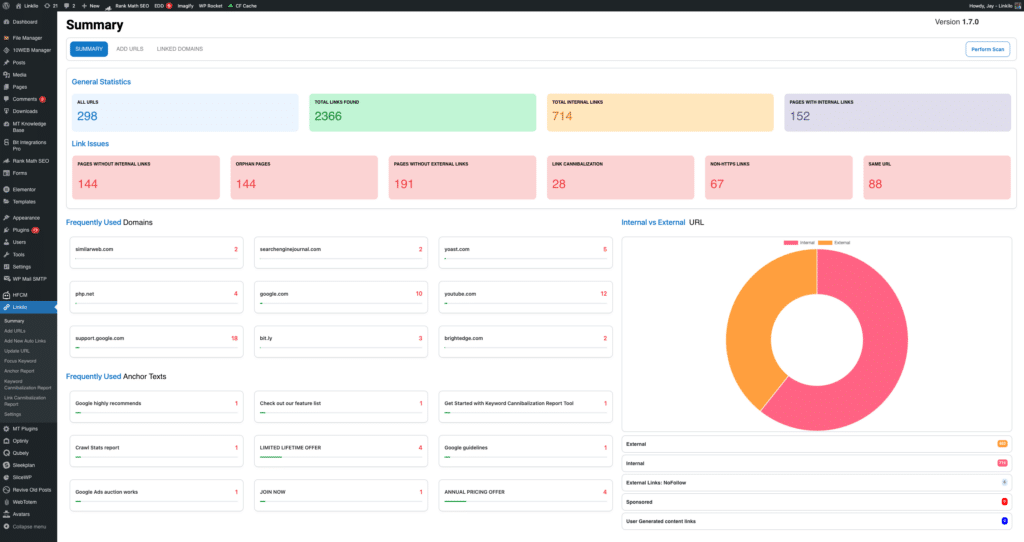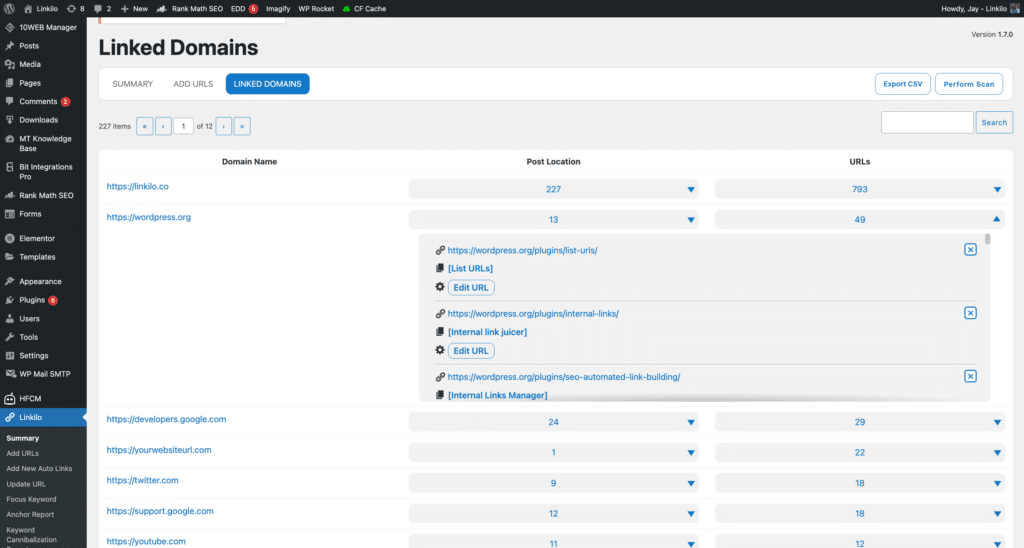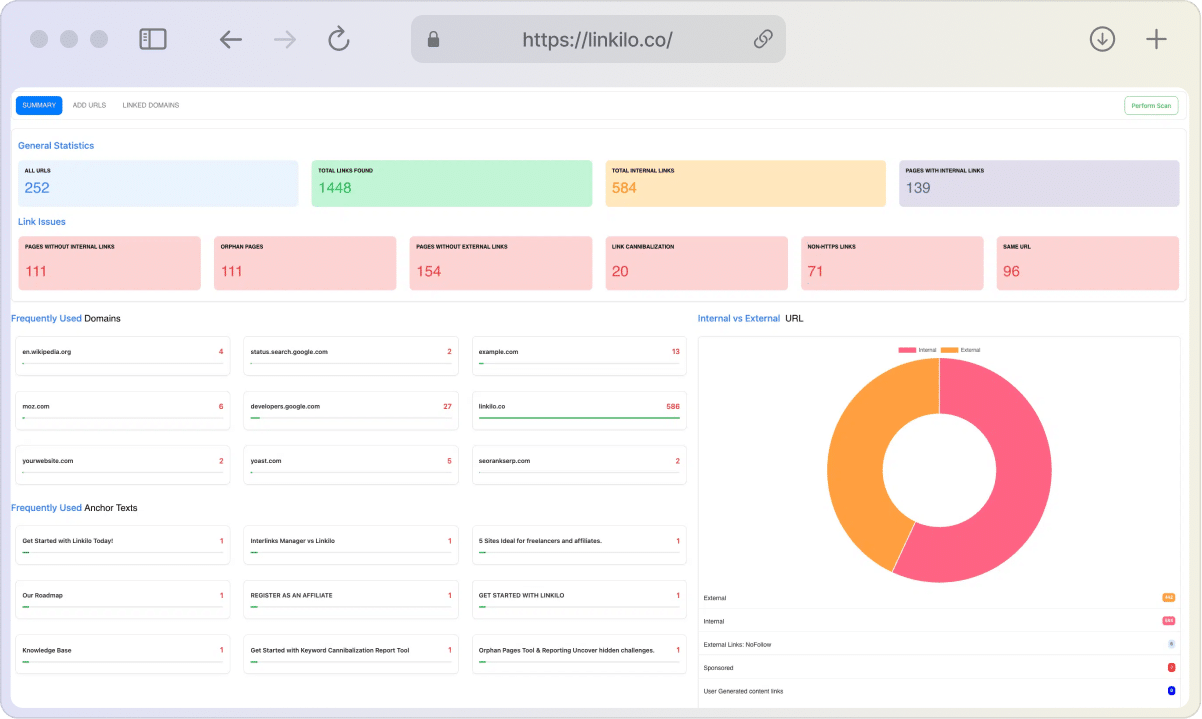Think of your website as an intricate railway network connecting several towns and cities. A well-managed, efficient railway enhances passengers’ experiences and ensures their safety, directing them effortlessly to their destinations.
Now, consider outbound links on your website as these railway tracks, guiding your users to other places of significance on the internet. A malfunctioning track, on the other hand, not only jeopardizes the journey but also undermines the trust placed in the entire network.
Monitoring the integrity and quality of these ‘digital tracks,’ also known as your outbound links, isn’t merely a chore to be occasionally dealt with. It’s a vital undertaking that directly affects the reputation of your website, the satisfaction of your users, and, remarkably, your SEO standings.
Let’s discuss why this task is indispensable and walk you through four proven techniques—using tools such as Linkilo for automated scrutiny—to help you stay ahead of the curve.
The Importance of Outbound Link Monitoring
Enhance Your Website’s Credibility and User Engagement
Functional and high-caliber outbound links enrich the user journey on your website. Directing your visitors to broken links or substandard web pages won’t just irritate them but will also tarnish your website’s reputation. By taking the time to validate your outbound links, you essentially polish the overall quality of your website, which invariably leads to longer sessions, lower bounce rates, and more conversions.
Circumvent Search Engine Penalties
Web crawlers don’t just look at the quality of content on your site; they also assess the destinations your website links to. Including links to suspicious or irrelevant websites may result in search engine penalties, reducing your website’s visibility. Monitoring the health and relevance of your outbound links thus becomes essential in preserving and even enhancing your search engine ranks.
Update Content to Keep It Current and Applicable
What might have been a groundbreaking article a year ago could be outdated today. Regular auditing of your outbound links enables you to replace those that lead to obsolete content with ones that offer updated, valuable information. In this manner, your website sustains its role as an authoritative source.
Methodical Approaches to Outbound Link Monitoring
Technique 1: Automating the Process with Linkilo
Linkilo is a link auditing tool for WordPress designed to simplify the otherwise intricate task of link monitoring. It features a user-friendly interface and presents critical data in digestible formats.

How Linkilo Functions:
- The Overview: After you log in, the Linkilo dashboard provides a snapshot of all your links, both internal and external.
- Detailed Reporting: The platform has a feature that allows you to go deeper into the specifics of your outbound links, shedding light on factors like their statuses and destination URLs.
- Comprehensive Domain Report: One of Linkilo’s most striking features is its exhaustive report on all the domains your website connects to, thereby enabling you to make bulk modifications to link attributes.

- Batch Operations: Need to modify or delete multiple links simultaneously? Linkilo allows you to do just that, reducing the time spent on link management.

- Granular Insight: Inside each page or post you can find what type of links you are using, if it is sponsored, opens in a new tab, and be able to change your outbound links individually to follow or nofollow.

Technique 2: Employing SEO Spiders Such as Screaming Frog
Another tool that can aid you in this process is Screaming Frog, an SEO spider designed to crawl your website and list all outbound links. The only downfall is that if you are using the free version, you are limited to 500 pages.
How Screaming Frog Operates:

- Initial Scanning: After inputting your website URL, Screaming Frog initiates a comprehensive crawl.
- Examining the External Tab: Once the crawl is completed, you can examine an ‘External’ tab that lists all outbound links, accompanied by details such as status codes and link counts.
Technique 3: Using SEO Platforms like Ahrefs
Ahrefs is another vital asset when it comes to link monitoring, especially with its Site Explorer functionality, designed to assess outbound links.
How Ahrefs Functions:
- Site Explorer Utility: The first step involves inputting your domain into the Ahrefs Site Explorer.
- Navigating to Outgoing Links: The interface has a “Link” section that provides a list of all the domains you are linking to.
- Focused Analysis: A dropdown menu allows you to investigate specific outbound links in detail.

Technique 4: Opting for Manual Checks on Smaller Websites
For websites that aren’t particularly expansive, performing manual checks is a plausible solution.
How to Conduct Manual Checks:
- Individual Page Navigation: The process involves manually navigating through every single page on your website. You can also use your sitemap.xml to find all your pages and go through them individually using a chrome extension like Detailed SEO and import or copy and paste all of this information into Google Sheets or Excel.
- Exhaustive Link Analysis: Either each outbound link is clicked to ensure it leads to a pertinent and functional web page, without the extension. Or you can use the extension to do some heavy leg work for you.

Why Linkilo is the Gold Standard for Link Monitoring
Linkilo emerges as the most efficient among the discussed methods, particularly for websites hosting an extensive number of pages. While manual checks still hold value for assessing the quality of the linked content, Linkilo provides a more streamlined, automated, and time-efficient way of maintaining your outbound links.
Conclusion: Make Outbound Link Audits Part of Your Regular sEO Strategy
Regularly checking your outbound links is not a task you perform and forget; it’s a recurring necessity. Consistent monitoring is instrumental in enhancing the user experience, maintaining optimal SEO performance, and reinforcing your site’s reputation as an authoritative information source. Therefore, choose the most appropriate method for your unique requirements, and consider making outbound link monitoring an integral part of your ongoing website management strategy.
So, if you’ve been viewing this task as a discretionary chore, it’s high time to shift your perspective. Consider it not as an addendum but as a cornerstone of your web strategy—a mandatory element that demands periodic attention for enduring success.
Would you like to read further about any specific points mentioned? Let us know, and we’ll be happy to provide more insights!




